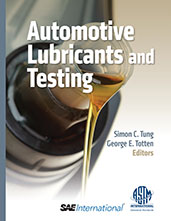Book

Automotive Lubricants and Testing
2012-10-31
This new book provides a comprehensive overview of various lubrication aspects of a typical powertrain system including the engine, transmission, driveline, chassis, and other components. The manual addresses major issues and current development status of automotive lubricant test methods. Topics also cover advanced lubrication and tribochemistry of the powertrain system, such as diesel fuel lubrication, specialized automotive lubricant testing development, filtration testing of automotive lubricants, lubrication of constant velocity joints, and biodegradable automotive lubricants.
